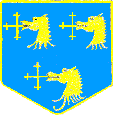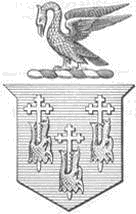

One of the most popular saints in the
later Middle Ages in the West, but there is no positive evidence she ever existed.
Her story is simply a fictional
romance. It relates that in the reign of Diocletion, a pagan priest of Antioch, Pisidia,
had a Christian daughter, Margaret. She rejected the advances of the Prefect Orybrius who
thereupon denounced her as a Christian.
The ordeals she then suffered are of
the most fabulous descriptions (including being swallowed by Satan in the form of a
dragon). Finally, she was beheaded. This farrago professes to have been written by an eye
witness, Margaret’s attendant Theotinus.
There are points of resemblance between
the cults of this Margaret and Catherine of Alexandria.
Margaret’s emblem was the dragon.
consisted of three dragons' heads, Or, swallowing crossed crosslets,
on an Azure Ground.
Crossed crosslets are like cross-shaped spears or
swords, with crosses on the hilts, which were carried by pilgrims. Presumably this is to
signify that Satan found Margaret's Christianity difficult to swallow.....rather like her
story!
This version of the town's arms was used on the
escutcheons of the Waites' original chains of office (see History). These chains, turned into Mayor's
and Deputy Mayor's chains in the nineteenth century, are on display at the Regalia Rooms attached
to the Town Hall.
Around 1878-1879 a photograph of Thomas J Seppings, Mayor,
wearing a chain made from three of the Waits’ chains, was taken. According to Hillen's
'History of King's Lynn' (1907), prior to 1872 the Mayor seldom wore the chain in
public.
1898 (14th September) The Mayor stated that he had had the silver Waits Chains belonging to the Corporation which were said to be charming examples of English work of about the year 1550 and consisted of Dragon head links with a suspending Shield of the Town Arms made into one chain which he suggested should in future be worn by the Ex-Mayor. And it is agreed that same be approved of.
(This chain was subsequently worn by the Deputy Mayor.)

By the late Nineteenth Century, the arms had changed little, apart from acquiring a crest consisting of a rather fanciful representation of a pelican. With typically heavy-handed early twentieth-century humour, Hillen has this to say about how to draw them:

To the local draughtsman in search of a model, we say:- Go to the nearest marsh and catch three dragons, as near the same weight as possible; tear - by no means cut - the heads from their bodies; press their jaws laterally, and with a spear, the peculiar construction of which must hereinafter be described, transfix each gaping head; arrange as in the above illustration, and, disregarding the natural colour, depict with bold outline and cross hatching in black, upon the best English gilt, so that the design in gold appears upon a blue background. If any difficulty be experienced (for dragons are said to be somewhat scarce in this neighbourhood), a resourceful artist might manage with one.
For a more accurate, up-to-date and readable history of the town, try 'KING'S LYNN' by Paul Richards, published by Phillimore (ISBN 0 85033 603 1)
The present arms of the Borough of King's Lynn and West Norfolk incorporate the arms of all the major towns in the Borough, including a version of the Lynn arms.